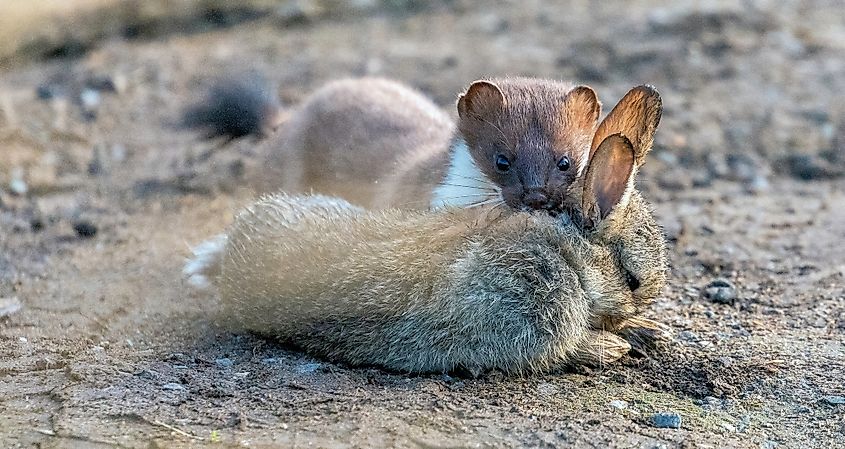
Stoat
Stoats—Mustela erminea—are carnivorous species of the mustelid family, related to weasels, otters, and ferrets. They are also known as short-tailed weasels and look similar to large weasels. Currently, there are over 35 known subspecies of stoats. Upon first glance, these carnivorous mammals may look adorable, but don't let their looks fool you—stoats are known as a notorious invasive species in parts of the world!
Characteristics Of The Stoat
Stoats are characterized by their slender bodies, short legs, reddish-brown fur, and a black, bushy tail. They are small mustelids that may weigh between 150 to 400 g with lengths spanning about 28 to 40 cm, including a tail, which usually measures around 9 to 14 cm. Females are smaller than males, with males capable of being up to 50% larger than their female counterparts.
Stoat's Habitat And Distribution

The distribution of stoats is widespread globally, in parts of North America, Europe, and Asia. Populations have even been found in the northern subarctic and Arctic regions. Stoats are considered adaptable species, adept at living in different habitats, landscapes, and elevations. They prefer to live in riparian woodlands, shrubby fencerows, marshes, alpine meadows, and open areas near forests or shrub borders. They can also be found in grasslands, orchards, heathland/moorlands, and coastal habitats. They have been known to live near human settlements, such as agricultural fields. Stoats typically live inside well-hidden dens but can also live inside tree trunks, hollow logs, or old rabbit burrows.
Food Habits Of The Stoat

Stoats are carnivorous predators, capable of hunting small rodents, rabbits, and invertebrates. They mainly hunt rabbits but are known to hunt voles, birds, mice, shrews, and eggs. Typically, they seize their small prey by the base of its skull. Despite their small size, stoats are able to hunt prey that are five times larger than themselves, seizing large prey by the neck. Stoats hunt and forage prey within their home range and make 2 to 3 hour-trips that are about 100 meters away from their dens. These mammals locate prey with their acute sense of smell, sight, hearing, and touch. They can also strategically "find" prey by running in a "zig-zag" pattern across their territory. Stoats are prey to hawks, owls, coyotes, foxes, and larger members of the weasel family.
Behavior And Reproduction
Stoats are agile climbers who can also swim across water gaps of up to 1.5 km. They may even swim longer distances with the assistance of a raft-like material like driftwood logs or other floating matter! Stoats are actively hunting during the day or night.
In the summer, stoats don a brown fur coat, camouflaging them against lush landscapes. In colder climates during the winter, a stoat's fur can become "ermines" when their fur turns completely white (except for their tail tips, which remain black). The fur also has an added density for extra warmth. This phenomenon enables the mammals to blend with the snowy terrain for protection. A stoat's fur can only become partially white in moderately cold climates.

Stoats are solitary creatures and travel alone, except for mating mothers with their older offspring. They can communicate through scent markings and occasionally occupy overlapping home ranges that are scent-marked. However, they can be intolerant to other stoats living in their range, especially if they are of the same gender. Though females generally remain in the territory where they were birthed for the rest of their lives, males generally travel and occupy large territories, often overlapping territories belonging to female stoats. Within their territory range, stoats may use several dens.
These carnivorous mammals mate in the summer, producing a single litter of 6 to 12 kits—or newborn stoats—a year. Female stoats can delay the implantation of a fertilized egg for up to 10 months before it starts to develop. This unique feature is a survival technique that ensures that a stoat's offspring are birthed at an optimal time, such as in conditions with adequate food availability. Stoats are a polygynandrous species and mate with multiple partners. The average life span of these mustelids is up to 7 years.
The Impacts Of Stoat On the Ecosystem

In New Zealand, stoats (along with weasels and ferrets) were introduced to the country as early as 1879 to control rabbit populations and maintain sheep pastures. Unfortunately, stoats negatively impacted New Zealand's bird species and populations, especially species like wrybills, the New Zealand dotterel, and young kiwi birds. As a result, many communities regard stoats as a pest or an invasive species due to their adaptive nature and reputation as opportunistic predators.
The International Union for Conservation of Nature classifies stoats as a species of "least concern" and it is said that its global population is abundant with no significant threats. However, local stoat populations can still be threatened by human trapping, habitat fragmentation, introductions with specific species, and changes in prey availability.
Humans And Stoats

Throughout history, humans hunted stoats and ermines for their thick fur, often used to craft clothing, from decorative pieces to ceremonial garbs. An ermine's thick winter coat was particularly prized for its color purity and fineness, making their furs highly prized. In the Middle Ages, during the reign of England's Edward III, ermine fur was permitted to be worn exclusively by members of the royal family and clergy. State robes were even crafted to distinguish a wearer's rank and position, based on the prominence of black spots within the fur.
In more recent times, ermine fur is used to make parkers and trims for slippers. Though a majority of the world's ermine fur supply is sourced from Eurasia, ermine fur originated elsewhere and may be exported to Europe to be dyed and made into jackets or coats.











